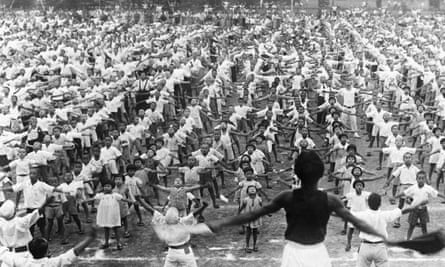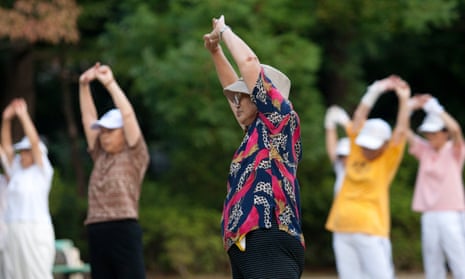“One, two, three, four … five, six, seven, eight …” That is the cue for half a dozen people braving a humid morning at Kamezuka park in Tokyo to bend, stretch, jump, and run on the spot. The group’s personal trainer is a portable radio perched on the top of a children’s slide. A male voice’s simple instructions, issued to a jaunty piano accompaniment, has become a staple of daily life in Japan since the broadcasts, known as rajio taisō (radio calisthenics), first hit the airwaves almost a century ago.
The three-minute routine is the perfect way to start the day, says Yukihide Maruyama, a 79-year-old retired businessman who has performed the routine nearly every day for a decade. “The exercises aren’t that difficult and afterwards you feel like your body has properly woken up.”
Japan’s communal exercise regime has barely changed since the health insurance bureau of the post office, inspired by morning exercises broadcast by the US insurance firm Metropolitan Life, launched rajio taisō in November 1928 to celebrate Emperor Hirohito’s formal ascension to the chrysanthemum throne.
Today, as Tokyo prepares to host the 2020 Olympics and Paralympics, Japan’s calisthenics community is hoping to raise interest in rajio taisō, with a mass workout at the end of this month involving 10 million people in every one of the country’s 47 prefectures, including 12,000 inside the Games’ main stadium.
After Japan’s defeat in the second world war, allied forces banned rajio taisō because of its close association with militarism. But in 1951, the education and health ministries enlisted experts and the life insurance industry to devise a new programme, to be broadcast on NHK public radio.

In 2003, the most recent year for which data is available, 27 million people said they took part in morning calisthenics more than twice a week, whether at work, at home in front of the TV or with neighbours in the local park. Children perform rajio taisō before school sports days or during special summer holiday sessions, earning credits that can be exchanged for snacks, stationery and other gifts.
Regular participants cover a broad cross-section of Japanese society: construction, factory and office workers, including the 10,000 employees of the Tokyo metropolitan government, who are encouraged to leave their desks and start moving at 3pm every weekday.
NHK radio broadcasts the routine four times a day – starting at 6:30am, except Sunday, while the TV version airs three times a day, except at weekends.
There are two standard routines – the second slightly more challenging than the first – each involving arm rotations, forward bends, straddle jumps and other aerobic exercises designed to move every muscle and leave participants slightly out of breath. In 1999, a routine was added for people who use wheelchairs or have other mobility issues.
“Studies show that people who exercise this way for just a few minutes a day have improved bone density, reduced risk of suffering a stroke or heart attack, and are generally in better physical shape than other people their age who don’t exercise,” says Yasuo Fukushi, secretary general of the Japan Radio Taiso Federation.
“There has never been any pressure to modernise the programme, because people have grown up with it and know it off by heart,” adds Fukushi, who believes the routine helps explain the impressive life expectancy of Japanese people.
“We even do this when it rains,” says Tomomi Okamoto, a company director who joins the Kamezuka park sessions in all weathers. “It gets the blood pumping and I always feel much better afterwards. It’s a great way to start the day,” she says. “But it’s not just about the exercise – it’s a way of communicating with your neighbours and getting to know people.”
Rajio taisō has gained a following in Brazil, Peru and other countries with large Japanese communities, and is behind a recent push in Britain to encourage older people to take more exercise amid warnings that, if left unaddressed, years of physical inactivity could cost the NHS at least £1.3bn in real terms between now and 2030.
In April, Sport England, in collaboration with the thinktank Demos, and Anchor Hanover, a care and housing provider for older people, launched 10 Today – a Lottery-funded six-month pilot programme that features 10-minute exercise programmes broadcast online and on two community radio stations three times a week.
“There is evidence that physically active older adults have lower rates of all-cause mortality, coronary heart disease, high blood pressure, stroke, type 2 diabetes, and colon and breast cancer compared with more inactive adults,” the report said.
The Kamezuka park regulars have finished their workout and, invigorated by their burst of activity, vow to return tomorrow. “Most of us are getting on, and it can be hard going on a cold, dark morning, but for some reason we all keep turning up,” says Maruyama, who has barely broken a sweat. “And I’d say we’re all in pretty good shape.”
